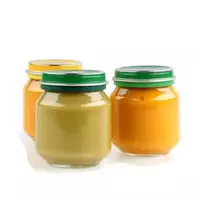Vegetable puree

In contrast to fruit puree, a vegetable-based product is considered the preferred option for the first complementary food. Although sometimes some mothers are surprised why, after a fruit treat, children refuse to eat pureed vegetables. Agree, after sweet fruit puree, it is unlikely that someone will give preference, although very useful, but with a less attractive taste of vegetable puree.
Meanwhile, the introduction of vegetable puree into the baby's diet is able to provide a small body with a number of useful nutrients that are so necessary during the growth period. These are vitamins, minerals (iron, potassium), dietary fiber, and proteins with carbohydrates.
There is a certain order according to which the mother must introduce the child to new products, in particular vegetable puree. First, it is customary to give mashed potatoes based on courgette, cauliflower or broccoli, after which you can gradually switch to complementary vegetable mashed potatoes from carrots, pumpkins and potatoes. Next in line are green peas and green beans. As for corn, only a can option can be used until a small person is
1. 5 years old.
Types of vegetable puree
First of all, speaking of various types of vegetable puree, it should be noted that it is customary to divide this product based on the raw materials used. Thus, one-component and multi-component vegetable puree stands out. The latter are a mixture of various vegetable crops, while one type of vegetable is used to make monocomponent puree.
The most common types of vegetable puree, which include one fruit type, are:
courgette puree;
mashed potatoes;
carrot puree;
beet puree;
cauliflower puree;
pumpkin puree;
broccoli puree.
In addition, such types of vegetable puree as green peas, as well as corn puree, are often on sale.
The calorie content of vegetable puree is low and averages about 24 kcal per 100 grams of product. However, their nutritional value directly depends on the range of raw materials used.
Composition of vegetable puree
In addition to the vegetable base, industrial vegetable puree often includes starch, which is used as a thickener, as well as ascorbic acid, which plays the role of an antioxidant.
As for the composition of vegetable puree, which mistresses are used to cooking at home, we can say that mainly in addition to boiled crushed vegetables, other components are not used in cooking. Salt and sugar are also not added if mashed potatoes are prepared for the child, since the later these substances are introduced into the baby's diet, the better for his health.
vegetable puree 24.18 kCal
Energy value of vegetable puree (Ratio of proteins, fats, carbohydrates - ju):
Proteins: 0.87 g (~ 3 kCal)
Fats: 0.09 g. (~ 1 kCal)
Carbohydrates: 5.63 g (~ 23 kCal)
Energy ratio (b | y): 14% | 3% | 93%
 Español
Español Français
Français Português
Português Русский
Русский 简体中文
简体中文 繁體中文
繁體中文 日本語
日本語 한국어
한국어 العربية
العربية Türkçe
Türkçe Қазақ
Қазақ Deutsch
Deutsch Italiano
Italiano Українська
Українська
